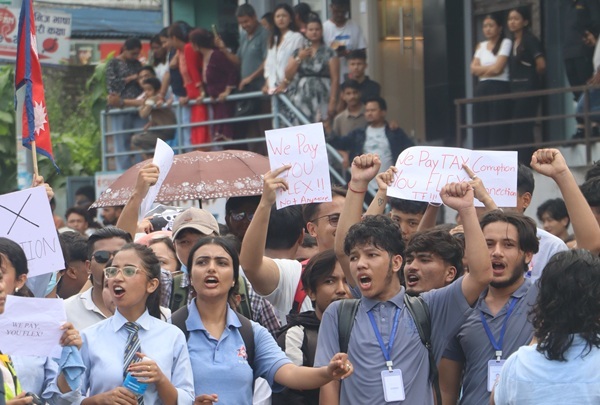.png)
Condescension Toward Gen Z is an Unmanaged Risk — Ask Nepal
Gen Z toppled a government with a hashtag. The real risk for India’s leaders and investors is still mispricing their power.


By Kirti Tarang Pande
Kirti Tarang Pande is a psychologist, researcher, and brand strategist specialising in the intersection of mental health, societal resilience, and organisational behaviour.
September 10, 2025 at 9:06 AM IST
You said that they can’t even finish a 3-minute video; yet their social media trend just overthrew a government.
Nepal’s parliament is in ashes. The Prime Minister has resigned. While international headlines reduce Nepal's movement to a protest about a social media ban, the truth is far more dangerous for investors: it was a legitimacy crisis. The ban was merely the spark; the fuel was decades of corruption and exclusion.
Are there lessons for us?
The lesson from Nepal isn’t just political. It is the same lesson that runs through workplaces, boardrooms, and markets: underestimating Gen Z is not a cultural quirk but a systemic mispricing error. A 2024 IIM-Ahmedabad survey revealed that 62% of hiring managers admit to designing workplace policies assuming younger cohorts “need handholding,” despite youth-led startups outperforming legacy sectors.
This condescension isn’t new.
Socrates is often quoted as saying, “The children now love luxury; they have bad manners, contempt for authority; they show disrespect for elders…” Every generation looks down on the next. Today, we disguise this disdain as strategy: “target Gen Z” — code for dumb it down, make it gimmicky. We tell teams to “write at the reading level of a 12-year-old.” But have you ever actually listened to a 12-year-old debate or recite spoken-word poetry?
Because the Nepalese uprising didn’t start with a Molotov cocktail, it started with a speech. A school captain, Avishkar Raut, delivered a “Jai Nepal” address that went viral not for a dance or gimmick, but for its piercing critique of corruption. His eloquence became the rallying cry of a movement.
This is Gen Z’s potential: purpose-driven, articulate, capable of sustained, collective focus. So, if we are indeed catering to the “reading level of a 12-year-old.” We are not designing for a deficit of intelligence, but for a surplus. Otherwise, we are too arrogant and presumptuous to see a catastrophic miscalculation backed by a century of psychological data.
The Flynn Effect, a cornerstone of psychological research, proves scientifically that each generation scores higher on intelligence tests than the last. A 2023 NCERT study found that today’s Class X students are performing at levels two grades ahead of their predecessors (that’s you and me). This isn’t an anecdotal story; it's empirical evidence!
This is where Positive Psychology provides our north star. The field isn’t about Pollyannaish optimism; it’s about the scientific study of what enables individuals and communities to flourish. Gen Z’s revolt in Nepal was a brutal, tragic exhibition of flourishing stifled. It was a cry for agency, purpose, and the ability to use signature strengths like critical thinking to build a future. When we dumb down products and policies, we don’t just condescend. We starve them of the nutrients for growth: mastery, challenge, meaning.
So, if we are really catering to Gen Z, we don’t need to ‘dumb down’ our product but smarten them up. This isn't about ethics; it's about alpha. The company that cracks the code on engaging Gen Z's actual intellect will capture the most valuable consumer and talent cohort of the next decade. The market reward for products that challenge, rather than pacify, will be enormous.
And the market is already rewarding those who get this right. Over 50% of India’s population is under 30. Startups targeting young consumers saw faster growth and higher investor confidence post-lockdown. EdTech companies added scores by engaging curiosity, not condescension. Paytm, PhonePe, and Groww didn’t succeed by dumbing things down; they built intentional architecture that gave youth mastery. The result? Triple-digit transaction growth.
The alpha is in harnessing intellect, not pandering to caricature.
But we are not doing this. Instead, we are compounding the error by blaming them for the very environments we engineered. The so-called 'short attention span' is not a generational trait; it is a designed outcome. It is the product of economic models built on addictive UX and variable-ratio reinforcement schedules. It’s the same psychology that powers slot machines. India’s mobile gaming sector grew 20% annually due to these attention-engineering tactics, popularised by millennial-founded studios. We built the cage of fragmented attention and then blamed the bird for not flying.
Nepal proves the potential remains intact, waiting only for a purpose worthy of it. Our algorithms consumed their attention, but not their capacity for grit and resilience. This is the ultimate refutation of the 'distracted youth' narrative. Policymakers who see a lack of focus are looking at a dormant volcano and mistaking it for a quiet mountain. This generation allegedly can't focus. Yet, in less than 48 hours, under curfew and live fire, they organised with breathtaking precision. They didn't just scroll; they stormed the streets. They didn't just cancel a politician online; they held a system accountable.
Youth RoI
Underestimating this is a profound failure of risk management (a classic Ostrich Effect) that leads to a herding panic that has the potential to scare capital. This is not a soft social issue; it is the hardest of economic indicators. Nepotism and exclusion in leadership (corporate and political) can trigger social unrest that directly affects markets. Gen Z’s intolerance of dynastic privilege is reshaping legitimacy and risk in South Asia.
The wise path forward is not to suppress this potential but to harness it through what we call Positive Design. We must move from exploiting hyperbolic discounting (the preference for immediate rewards) to building 'intentional architecture' in products and policies that foster long-term thinking, civic engagement, and trust. This is already proving to be a phenomenal business strategy. India’s “Digital Detox” market for anti-addiction apps grew 31% as burnout costs hit ₹32 billion. Policies at Infosys and TCS that limited addictive UX patterns boosted employee satisfaction scores. They provided mastery, not just manipulation.



